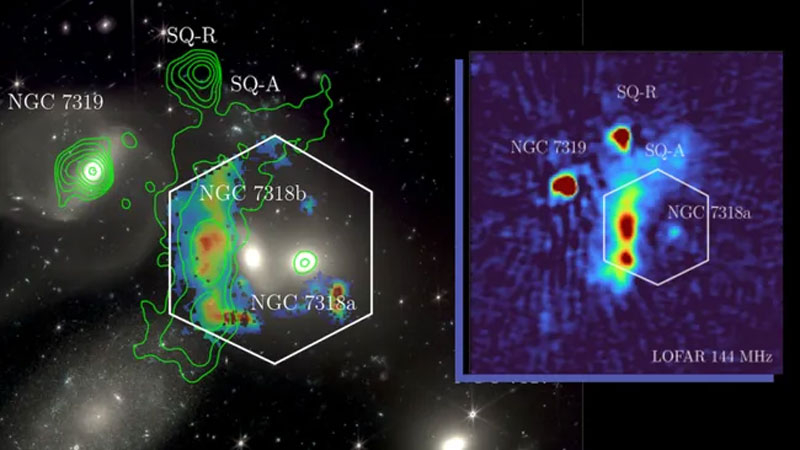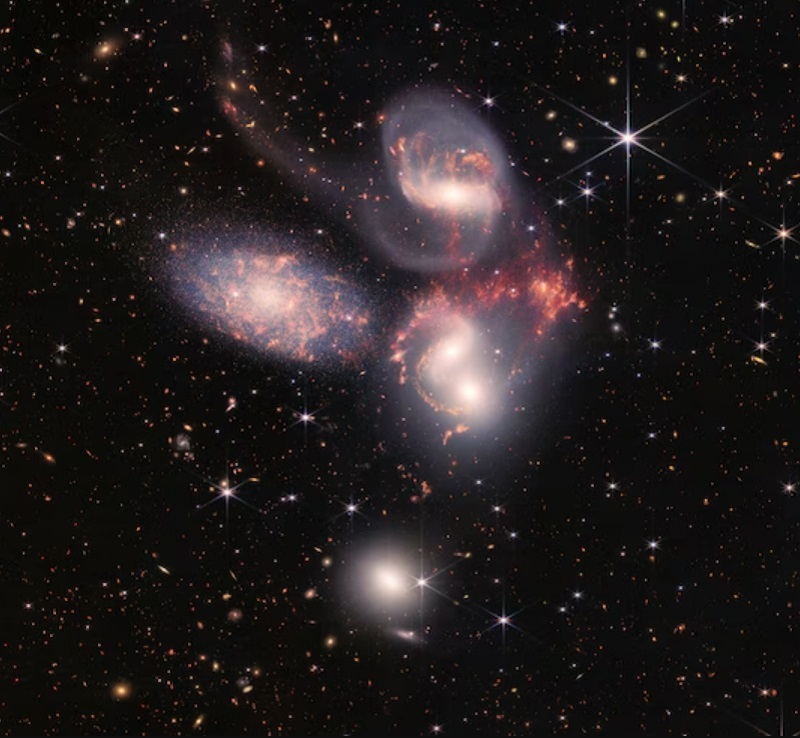It is no secret that galaxies can collide, which leads to changes in the landscape of the Universe and to the evolution of the galaxies themselves. Studying the consequences of such phenomena will allow us to better understand the fundamental processes of the universe and increase the accuracy of forecasting. The most interesting object in this regard remains the most dangerous “crossroads” in the Universe – the so-called Stefan Quintet, where galaxies collided before and are colliding now.

Combined data. Image source: William Herschel Telescope Enhanced Area Velocity Explorer
The interest in Stefan’s Quintet, a group of four interacting galaxies (the fifth was accidentally in the frame), is underscored by the fact that James Webb captured this object in his very first scientific imaging session as soon as he began scientific work. Previously, Stefan’s Quintet was photographed by other optical and radio telescopes. The latter provide the most complete picture of the distribution of gas and dust in the collision region and the behavior of the shock wave front from the colliding galaxy halos.
In the new work, scientists combined data from the Low Frequency Array (LOFAR), Very Large Array radio telescopes and the William Herschel Telescope Enhanced Area Velocity Explorer (WEAVE) spectrometer at the telescope. William Herschel in La Palma (Spain) with images of “James Webb”. The overall data helped to reproduce in detail the site of the “accident”, during which the galaxy NGC 7318b crashed into the remains of previous collisions at a speed of 3.2 million km/h. The speed of the shock wave front turned out to be so high that it was able to rip electrons from the orbits of atoms of interstellar gas and dust. Regions of plasma have emerged that are clearly visible in radio telescope data and on the spectrometer.
«Since its discovery in 1877, Stefan’s Quintet has captivated astronomers because it represents a galactic crossroads where past collisions between galaxies have left behind a complex field of debris, said Marina Arnaudova, team leader and researcher at the University of Hertfordshire. – Dynamic activity in this group of galaxies has now resumed due to the galaxy rushing through it at an incredible speed of over 2 million miles per hour (3.2 million km/h), resulting in an extremely powerful impact, much like a sonic boom fighter jet.” Only this “fighter” moved 800 times faster than usual…

Stefan’s Quintet on Webb’s Footage
«Along with the details of the impact and unfolding collision that we see in Stefan’s Quintet, these observations provide a remarkable glimpse into what may be going on in the formation and evolution of the faint faint galaxies we see at the limit of our current capabilities,” added another author of the paper. .
This was the first observation for the WEAVE robotic spectrometer. The device began operating in 2022 and since then has occupied 70% of the observing time of the telescope on which it is installed. With its help, many new discoveries are expected.